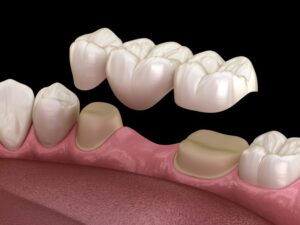What Might Cause a Dental Bridge to Fail?
July 3, 2025

Dental bridges are a reliable and effective way to replace missing teeth, restoring both function and appearance. They can last many years with proper care, but like any dental restoration, bridges are not indestructible. Understanding the reasons why a dental bridge might fail can help you take the right steps to protect your investment and keep your smile healthy.
Poor Oral Hygiene
One of the most common causes of dental bridge failure is inadequate oral hygiene. While the bridge itself cannot develop cavities, the natural teeth that support it—called abutment teeth—remain vulnerable to decay. If plaque and bacteria build up around the edges of the bridge, cavities and gum disease can weaken these supporting teeth. Once the abutment teeth are compromised, the bridge can loosen or fail. Brushing twice daily, flossing underneath the bridge, and using interdental brushes or water flossers are essential for long-term success.
Gum Disease
Healthy gums are crucial to the stability of a dental bridge. If gum disease develops and progresses, it can destroy the bone and tissue that support the abutment teeth. This leads to loosening of the bridge and eventual failure. Early stages of gum disease, such as gingivitis, may cause bleeding gums and irritation, but advanced gum disease (periodontitis) can cause permanent damage. Regular dental cleanings and checkups help prevent gum disease and preserve the foundation of your bridge.
Bite Problems or Misalignment
If your bite is not properly balanced, excessive pressure may be placed on your dental bridge. This uneven stress can cause the bridge to crack, loosen, or even damage the abutment teeth. Grinding or clenching your teeth (a condition known as bruxism) can also contribute to premature wear and failure. If you grind your teeth, your dentist may recommend a nightguard to protect both your bridge and natural teeth.
Poor Fit or Placement
The success of a dental bridge also depends heavily on how well it is designed and placed. A poorly fitted bridge may leave gaps where bacteria can accumulate, leading to decay or gum irritation. Additionally, if the abutment teeth are not properly prepared or strong enough to support the bridge, it can become unstable over time. Choosing an experienced dentist who uses precise techniques and quality materials is key to ensuring a secure, long-lasting restoration.
Natural Wear and Tear
Even with excellent care, no dental restoration lasts forever. Chewing, biting, and daily use naturally wear down bridges over the years. On average, dental bridges last between 7 and 15 years, but many can last longer with proper maintenance. Over time, the cement holding the bridge in place may weaken, or the materials may show signs of aging, requiring replacement.
A dental bridge can give you back a complete smile and improve your quality of life, but it requires ongoing care and attention. Poor oral hygiene, gum disease, bite issues, improper placement, and natural wear are the leading causes of bridge failure. By maintaining excellent dental habits, visiting your dentist regularly, and addressing any issues early, you can extend the lifespan of your bridge and keep your smile healthy for years to come.
About the Practice
If you’re looking to fix a gap in your grin, trust the experts at Randolph Dental Care to provide you with just the right solution: a dental bridge! We can carry out the procedure for a dental implant bridge under one roof, so you won’t need to make a trip to another dentist for a referral. We’re a proud family-owned and operated dental practice that’s insurance friendly and offers flexible financing options as well to ease the burden of costs to you. Simply schedule your appointment online to get started or call us at (973) 895-7995.
No Comments
No comments yet.
RSS feed for comments on this post.
Sorry, the comment form is closed at this time.









